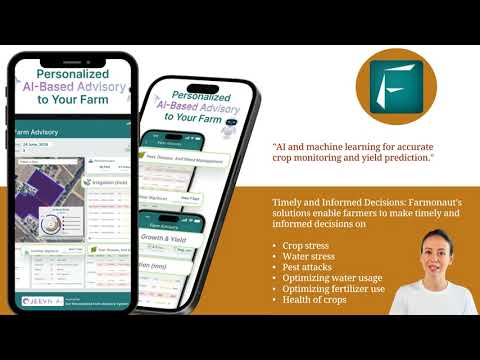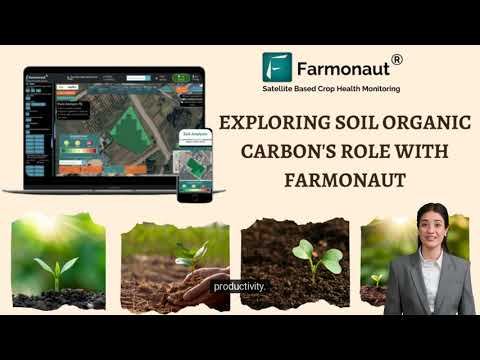Revolutionizing U.S. Soybean Farms: How Dirks Bros and Farmonaut’s Precision Farming Technology Boosts Yields and Sustainability
“Farmonaut’s satellite-based crop monitoring technology analyzes NDVI and vegetation indices to provide real-time insights on soybean health.”
In the ever-evolving landscape of agriculture, we are witnessing a remarkable transformation in the way U.S. soybean farms operate. The integration of precision farming technology and sustainable agriculture solutions is revolutionizing the industry, leading to increased yields, improved efficiency, and enhanced sustainability. At the forefront of this agricultural revolution are innovative companies like Dirks Bros and Farmonaut®, whose expertise and cutting-edge technologies are reshaping the future of farming.
In this comprehensive blog post, we’ll explore how the combination of Dirks Bros’ crop fertility management techniques and Farmonaut’s satellite-based crop monitoring is creating a new paradigm in modern agriculture. We’ll delve into the intricacies of these smart farming techniques, examine their impact on U.S. soybean farms, and discuss the broader implications for the future of sustainable agriculture.
The Evolution of Precision Farming Technology
Precision farming, also known as precision agriculture, is a farming management concept that uses information technology to ensure that crops and soil receive exactly what they need for optimum health and productivity. This approach aims to increase efficiency, maximize yields, and reduce waste by using the most accurate and precise methods and tools available.
Over the years, precision farming has evolved from simple grid sampling and variable rate application to sophisticated, data-driven systems that leverage satellite imagery, GPS technology, and advanced analytics. This evolution has been driven by the need to address several key challenges in agriculture:
- Increasing global food demand
- Limited arable land
- Climate change and environmental concerns
- Resource scarcity (water, fertilizers, etc.)
- Economic pressures on farmers
The integration of precision farming technology in U.S. soybean farms has led to significant improvements in crop management, resource utilization, and overall farm productivity. Let’s explore how Dirks Bros and Farmonaut are contributing to this agricultural revolution.
Dirks Bros: Pioneering Crop Fertility Management
Dirks Bros has established itself as a trusted name in crop fertility solutions, bringing decades of experience and expertise to the table. Their approach to precision farming focuses on optimizing soil health and nutrient management, which are critical factors in maximizing soybean yields. Here’s how Dirks Bros is making a difference:
1. Advanced Soil Mapping and Sampling
Dirks Bros employs cutting-edge tools like Radicle Agronomics and SWAT MAPS to provide accurate soil insights. These technologies allow for high-resolution soil mapping, giving farmers a detailed understanding of their field’s soil composition, texture, and nutrient levels. This precision in soil analysis forms the foundation for all subsequent crop management decisions.
2. Custom Fertilizer Blends
Based on the detailed soil analysis, Dirks Bros creates tailored nutrient solutions for different soil types within a field. This customized approach ensures that each area of the farm receives the exact blend of nutrients it needs, optimizing crop growth while minimizing waste.
3. Precision Application
Utilizing GPS-guided equipment and variable rate technology, Dirks Bros ensures that fertilizers are applied exactly where and when they are needed. This precision in application not only improves nutrient uptake by the crops but also reduces the environmental impact of excess fertilizer runoff.
4. Continuous Crop Monitoring
Dirks Bros doesn’t stop at initial soil analysis and fertilizer application. They provide ongoing crop monitoring services, helping farmers maintain healthier, more productive fields throughout the growing season. This continuous assessment allows for timely interventions and adjustments to the crop management strategy.
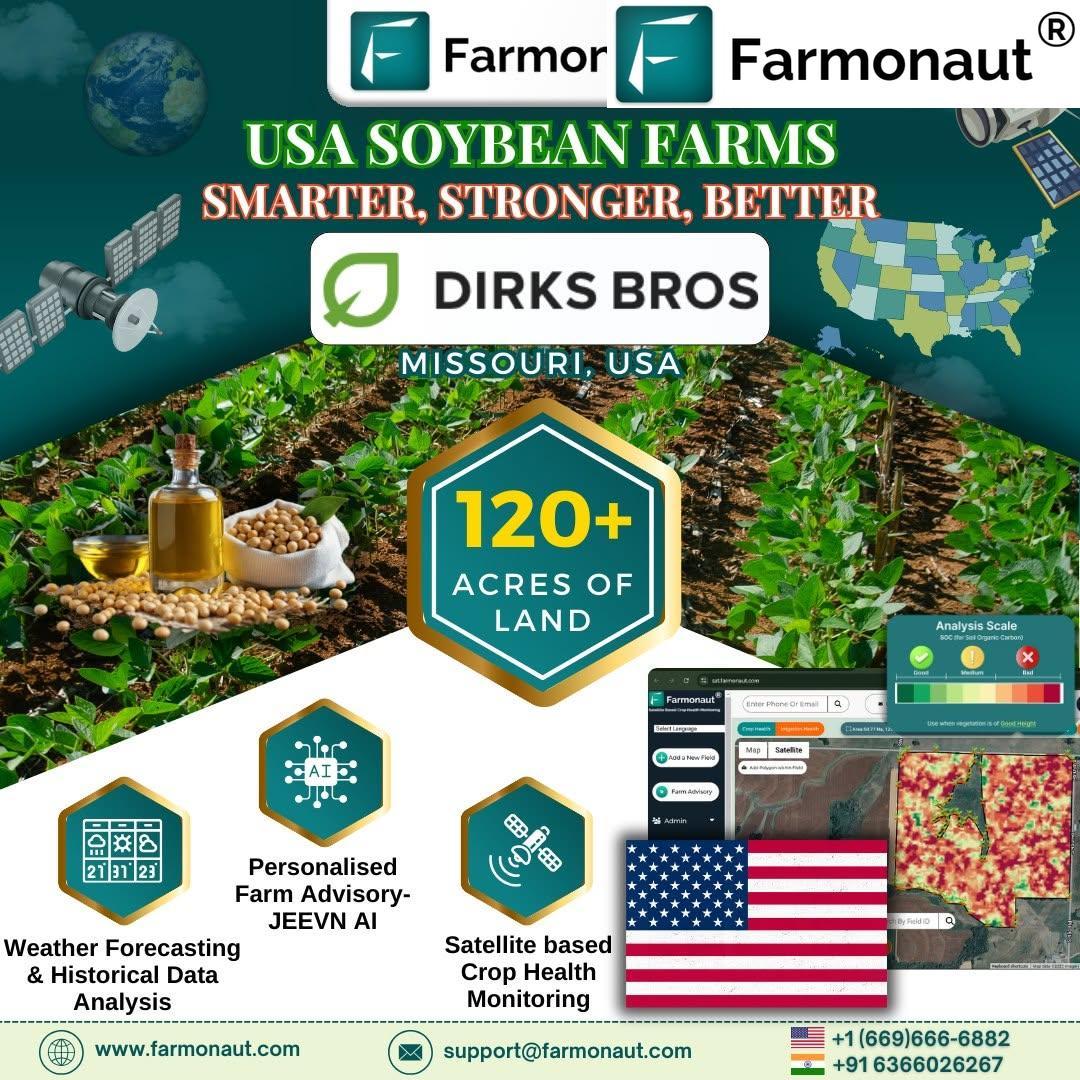
Farmonaut: Revolutionizing Crop Monitoring with Satellite Technology
Farmonaut brings a new dimension to precision farming with its advanced satellite-based crop monitoring technology. By leveraging the power of remote sensing and artificial intelligence, Farmonaut provides farmers with unprecedented insights into their crops’ health and performance. Here’s how Farmonaut is transforming soybean farming:
1. Real-Time Crop Health Monitoring
Farmonaut’s satellite-based technology offers real-time insights into crop health and soil conditions. By analyzing multispectral imagery, the system can detect early signs of crop stress, pest infestations, or nutrient deficiencies long before they become visible to the naked eye. This early detection capability allows farmers to take proactive measures, potentially saving entire crops from failure.
2. NDVI and Vegetation Indices
Farmonaut utilizes Normalized Difference Vegetation Index (NDVI) and other vegetation indices to assess crop health and vigor. These indices provide a quantitative measure of vegetation by observing the distinct ways in which healthy and stressed vegetation reflect light. This information helps farmers identify areas of their fields that may require immediate attention or different management strategies.
3. Weather and Historical Data Analytics
By integrating current weather data with historical trends, Farmonaut’s system supports better farm management decisions. Farmers can anticipate weather-related risks, optimize irrigation schedules, and plan other field operations with greater accuracy. This data-driven approach helps minimize the impact of adverse weather conditions on crop yields.
4. Mobile Access and Digital Insights
Farmonaut’s platform is accessible through web and mobile applications, giving farmers easy access to field data anytime, anywhere. This mobility allows for quick decision-making and timely interventions, even when farmers are not physically present in their fields.
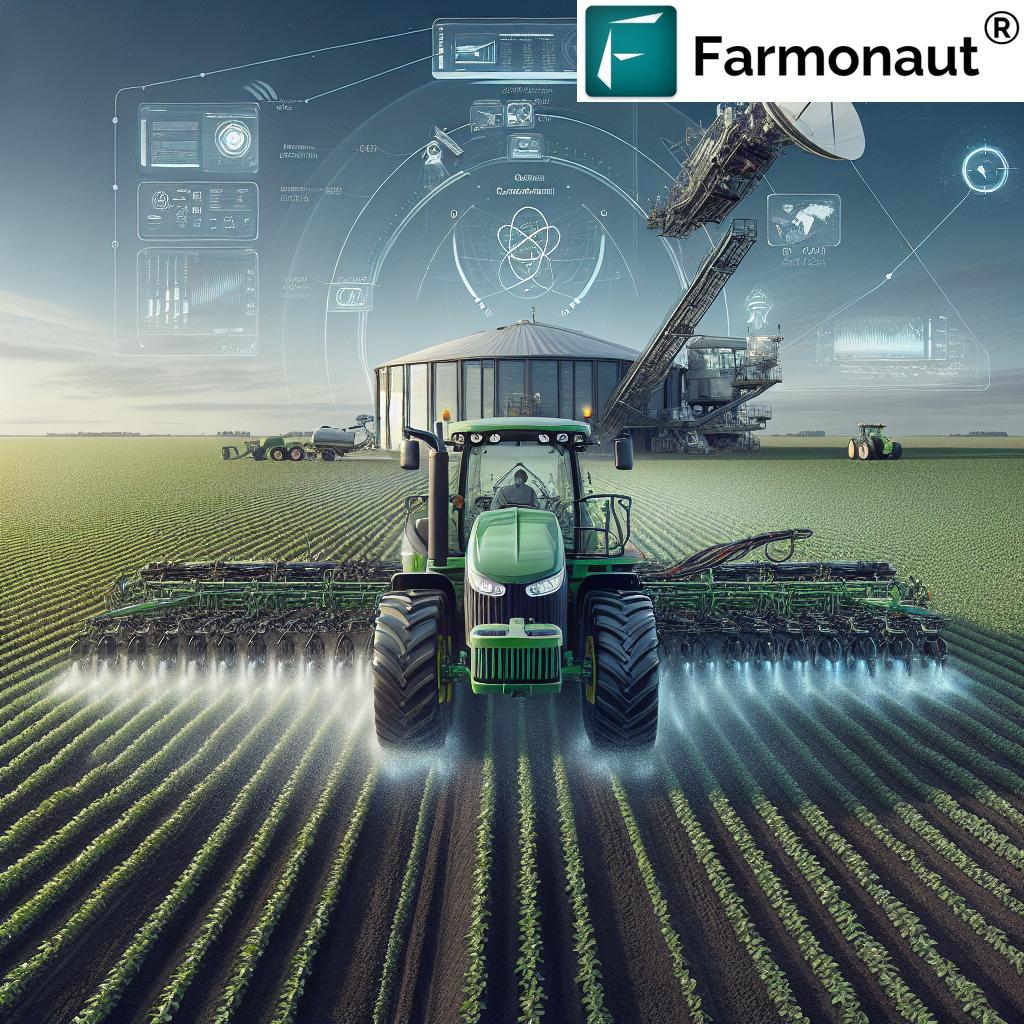
“Dirks Bros’ precision farming techniques, combined with Farmonaut’s technology, can significantly increase soybean yields while reducing resource waste by up to 30%.”
The Synergy of Expertise and Technology
The combination of Dirks Bros’ expertise in crop fertility management and Farmonaut’s advanced satellite-based monitoring creates a powerful synergy that is transforming U.S. soybean farms. This integration of knowledge and technology offers several key benefits:
1. Data-Driven Decision Making
By combining Dirks Bros’ detailed soil analysis with Farmonaut’s real-time crop health data, farmers can make more informed decisions about every aspect of their operation. From determining the optimal planting date to adjusting fertilizer applications mid-season, this data-driven approach takes much of the guesswork out of farming.
2. Optimized Resource Management
The precision offered by this integrated approach allows for more efficient use of resources. Farmers can apply water, fertilizers, and pesticides exactly where and when they’re needed, reducing waste and minimizing environmental impact. This not only lowers input costs but also promotes more sustainable farming practices.
3. Increased Yields and Profitability
By addressing the specific needs of each area within a field and responding quickly to potential issues, farmers can significantly increase their soybean yields. Higher yields, combined with reduced input costs, translate to improved profitability for farm operations of all sizes.
4. Enhanced Sustainability
The precision and efficiency offered by this technology integration lead to more sustainable farming practices. Reduced chemical runoff, improved soil health, and lower water usage all contribute to a more environmentally friendly approach to soybean farming.
Implementing Precision Farming Technology on U.S. Soybean Farms
The implementation of precision farming technology on U.S. soybean farms involves several key steps:
1. Initial Assessment and Planning
The process begins with a comprehensive assessment of the farm’s current practices, soil conditions, and historical yield data. This information is used to develop a tailored precision farming strategy that addresses the specific needs and challenges of each farm.
2. Technology Integration
The next step involves integrating the necessary technologies, including GPS-guided equipment, soil sensors, and access to Farmonaut’s satellite monitoring platform. Farmers and their teams receive training on how to use these new tools effectively.
3. Data Collection and Analysis
Once the systems are in place, the farm begins collecting detailed data on soil conditions, crop health, weather patterns, and other relevant factors. This data is analyzed using advanced algorithms to generate actionable insights.
4. Precision Application
Based on the analyzed data, farmers can implement precision application of inputs such as fertilizers, water, and pesticides. Variable rate technology allows for different application rates within the same field, optimizing resource use.
5. Continuous Monitoring and Adjustment
Throughout the growing season, Farmonaut’s satellite monitoring provides ongoing insights into crop health and development. This allows farmers to make timely adjustments to their management strategies as needed.
6. Post-Season Analysis
After harvest, a thorough analysis of the season’s data helps farmers and agronomists identify areas for improvement and refine their strategies for the next growing season.
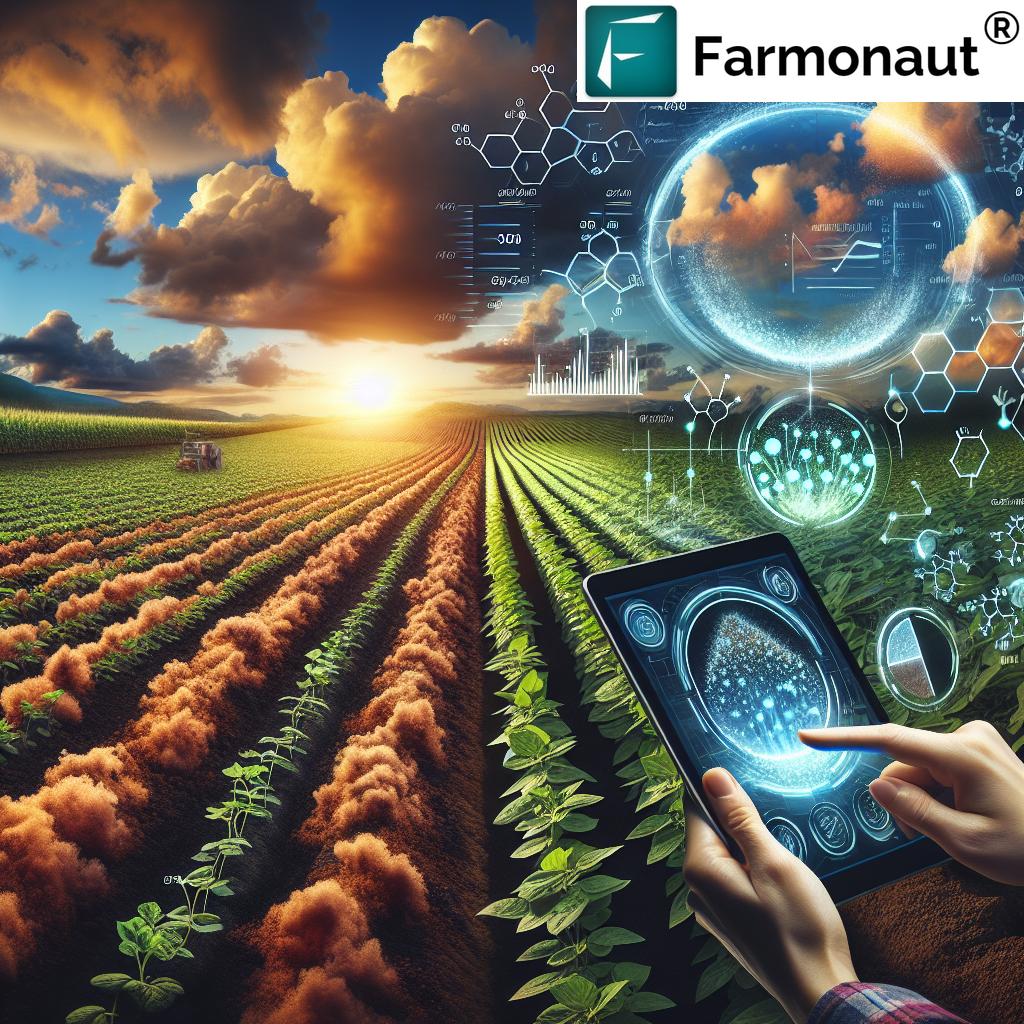
The Impact on U.S. Soybean Production
The adoption of precision farming technology is having a significant impact on U.S. soybean production:
1. Increased Yields
Farmers implementing these technologies are seeing substantial increases in soybean yields, with some reporting improvements of up to 20% or more.
2. Improved Resource Efficiency
Precision farming techniques are leading to more efficient use of water, fertilizers, and pesticides, with some farms reporting reductions in input use of up to 30%.
3. Enhanced Soil Health
By optimizing nutrient management and reducing chemical inputs, these practices are contributing to improved long-term soil health and sustainability.
4. Greater Resilience
The data-driven approach allows farmers to better anticipate and respond to challenges such as weather extremes or pest outbreaks, increasing the resilience of their operations.
5. Economic Benefits
Higher yields and reduced input costs are translating into improved profitability for soybean farmers, helping to ensure the long-term viability of their operations.
The Future of Precision Farming in U.S. Soybean Production
As technology continues to advance, we can expect to see even more innovative solutions in precision farming for soybean production. Some exciting developments on the horizon include:
1. AI-Powered Predictive Analytics
Advanced artificial intelligence algorithms will provide even more accurate predictions of crop performance, pest outbreaks, and optimal management strategies.
2. Integration of IoT Devices
The Internet of Things (IoT) will allow for even more detailed real-time monitoring of field conditions through a network of connected sensors.
3. Autonomous Farm Equipment
Self-driving tractors and drones capable of performing tasks like planting, fertilizing, and pest control with minimal human intervention are becoming a reality.
4. Blockchain for Traceability
Blockchain technology will enable better traceability of soybeans from farm to table, enhancing food safety and consumer trust.
5. Gene Editing and Precision Breeding
Advances in gene editing techniques like CRISPR will allow for the development of soybean varieties tailored to specific growing conditions and resistant to pests and diseases.
As these technologies continue to evolve and become more accessible, we can expect to see even greater improvements in the efficiency, sustainability, and profitability of U.S. soybean farms.
Comparison of Traditional vs. Precision Farming Techniques
| Farming Aspect | Traditional Method | Precision Farming Method |
|---|---|---|
| Soil Mapping | Uniform soil sampling | High-resolution soil mapping with GPS technology |
| Fertilizer Application | Uniform application across fields | Variable rate application based on soil needs |
| Crop Monitoring | Visual inspection and periodic sampling | Real-time satellite-based monitoring with NDVI analysis |
| Decision Making | Based on experience and general guidelines | Data-driven decisions using AI and predictive analytics |
| Resource Efficiency | Moderate | High (up to 30% reduction in input use) |
| Average Yield Increase | Baseline | Up to 20% or more |
| Environmental Impact | Higher risk of runoff and over-application | Reduced environmental impact due to precise application |
| Long-term Soil Health | Variable, depending on practices | Improved due to optimized nutrient management |
Challenges and Considerations
While the benefits of precision farming technology are clear, there are some challenges and considerations that farmers and industry stakeholders need to address:
1. Initial Investment
The upfront costs of implementing precision farming technology can be significant. Farmers need to carefully consider the return on investment and may require financial support or incentives to adopt these technologies.
2. Technical Expertise
Implementing and effectively using precision farming tools requires a certain level of technical knowledge. Ongoing training and support are essential to ensure farmers can fully leverage these technologies.
3. Data Management and Privacy
The large amount of data generated by precision farming systems raises questions about data ownership, security, and privacy. Clear guidelines and robust data management practices are necessary.
4. Connectivity in Rural Areas
Many precision farming technologies rely on internet connectivity, which can be limited in some rural areas. Improving rural broadband infrastructure is crucial for widespread adoption.
5. Integration with Existing Systems
Farmers often need to integrate new technologies with existing equipment and practices. Ensuring compatibility and smooth integration can be challenging.
The Role of Policy and Industry Support
To fully realize the potential of precision farming technology in U.S. soybean production, support from both policymakers and industry leaders is crucial. Some key areas of focus include:
1. Research and Development Funding
Continued investment in research and development of precision farming technologies will drive innovation and improve accessibility.
2. Education and Training Programs
Developing comprehensive education and training programs will help farmers and agricultural professionals acquire the skills needed to implement and manage precision farming systems effectively.
3. Financial Incentives
Providing financial incentives or subsidies for adopting precision farming technologies can help overcome the initial cost barrier for many farmers.
4. Infrastructure Development
Investing in rural broadband and other necessary infrastructure will support the widespread adoption of precision farming technologies.
5. Regulatory Framework
Developing clear regulations around data ownership, privacy, and sharing will help build trust and encourage adoption of precision farming practices.
Conclusion: A New Era for U.S. Soybean Farming
The integration of precision farming technology, as exemplified by the advanced solutions offered by companies like Dirks Bros and Farmonaut, is ushering in a new era for U.S. soybean farming. By combining expert knowledge in crop fertility management with cutting-edge satellite-based monitoring, these technologies are enabling farmers to optimize their operations, increase yields, and improve sustainability.
As we look to the future, it’s clear that precision farming will play an increasingly crucial role in meeting the global demand for soybeans while addressing the challenges of resource scarcity and environmental sustainability. The continued evolution of these technologies, coupled with supportive policies and industry collaboration, will be key to ensuring the long-term success and resilience of U.S. soybean farms.
For farmers looking to stay competitive in this rapidly changing landscape, embracing precision farming technology is no longer just an option—it’s becoming a necessity. By leveraging these advanced tools and techniques, U.S. soybean farmers can position themselves at the forefront of agricultural innovation, driving productivity, profitability, and sustainability for years to come.
FAQ Section
Q1: What is precision farming technology?
A1: Precision farming technology is an approach that uses information technology and a wide array of items such as GPS guidance, control systems, sensors, robotics, drones, autonomous vehicles, variable rate technology, GPS-based soil sampling, automated hardware, telematics, and software to optimize crop yields and reduce resource waste.
Q2: How does satellite-based crop monitoring work?
A2: Satellite-based crop monitoring uses multispectral imagery from satellites to analyze crop health, soil moisture, and other field conditions. It employs various vegetation indices, such as NDVI, to provide farmers with real-time insights into their crops’ status and potential issues.
Q3: What are the main benefits of precision farming for soybean producers?
A3: The main benefits include increased yields, improved resource efficiency, enhanced soil health, greater resilience to environmental challenges, and improved profitability through optimized input use and higher crop quality.
Q4: How does precision farming contribute to sustainability in agriculture?
A4: Precision farming contributes to sustainability by optimizing resource use, reducing chemical runoff, improving soil health, and minimizing environmental impact through targeted application of inputs and better land management practices.
Q5: What are some challenges in implementing precision farming technologies?
A5: Challenges include high initial investment costs, the need for technical expertise, data management and privacy concerns, connectivity issues in rural areas, and integration with existing farm equipment and practices.
Earn With Farmonaut: Affiliate Program
Earn 20% recurring commission with Farmonaut’s affiliate program by sharing your promo code and helping farmers save 10%. Onboard 10 Elite farmers monthly to earn a minimum of $148,000 annually—start now and grow your income!
Ready to revolutionize your farming practices? Explore Farmonaut’s cutting-edge solutions:
For developers interested in integrating Farmonaut’s powerful satellite and weather data into their own applications, check out our API and API Developer Docs.


